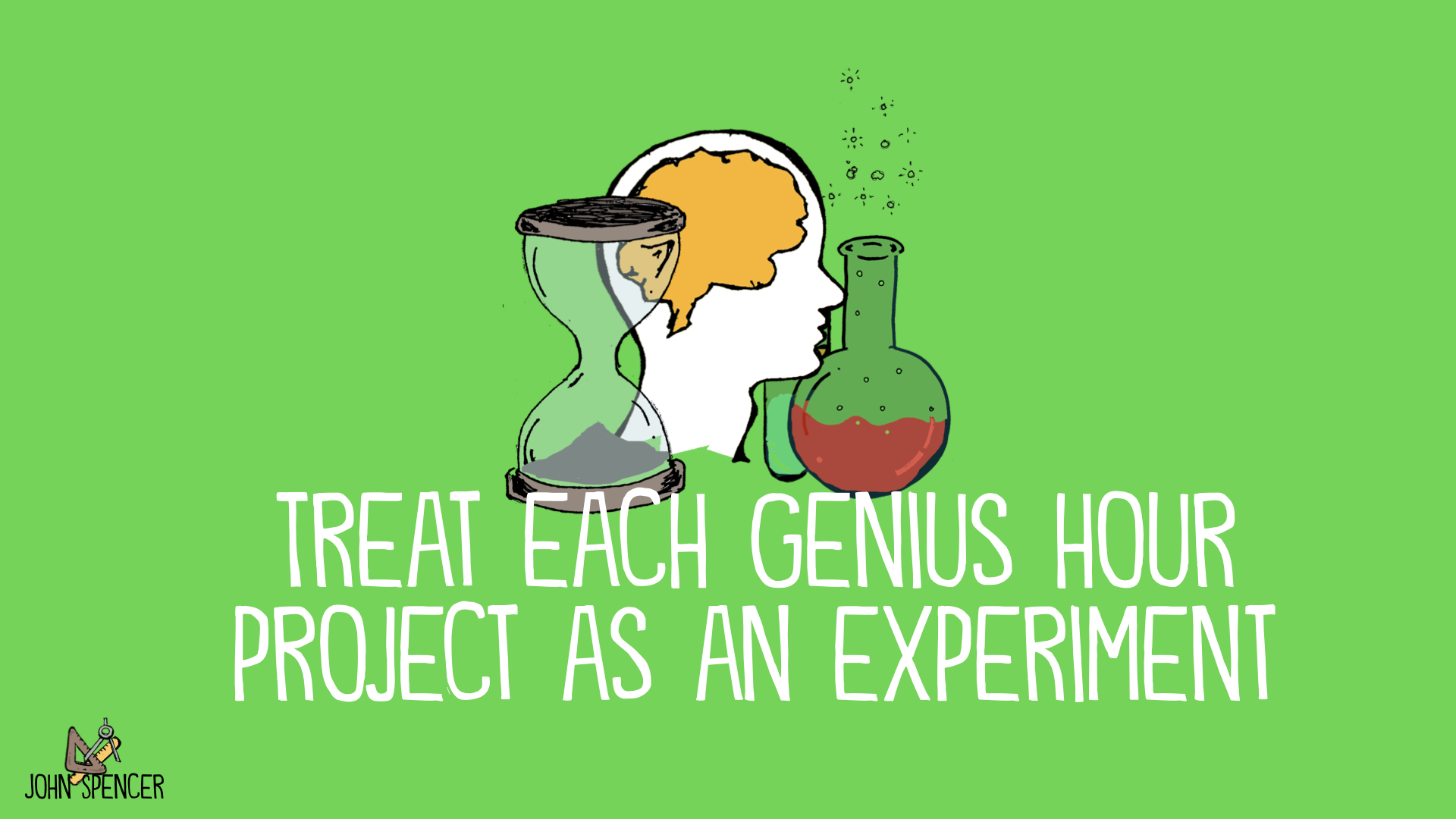Treat Each Genius Hour Project as an Experiment
Education Rethink 2021-01-11
Last year, I began creating stickers, sweatshirts, and t-shirts with my own sketches on them. I figured it would be fun to give some t-shirts and stickers away when I do keynotes or workshops. But honestly, it wasn’t really about professional development. It was about that magical moment that happens when you sketch something by hand and then it eventually ends up on a physical item. I wear my black hoodie with the white greyhound sketch on it all the time because it brings me joy.
 If you look at my notebook or water bottle, you’ll see a few of my stickers. In some cases, they are downright silly (like my version of the NASA logo in a Star Wars theme):
If you look at my notebook or water bottle, you’ll see a few of my stickers. In some cases, they are downright silly (like my version of the NASA logo in a Star Wars theme):
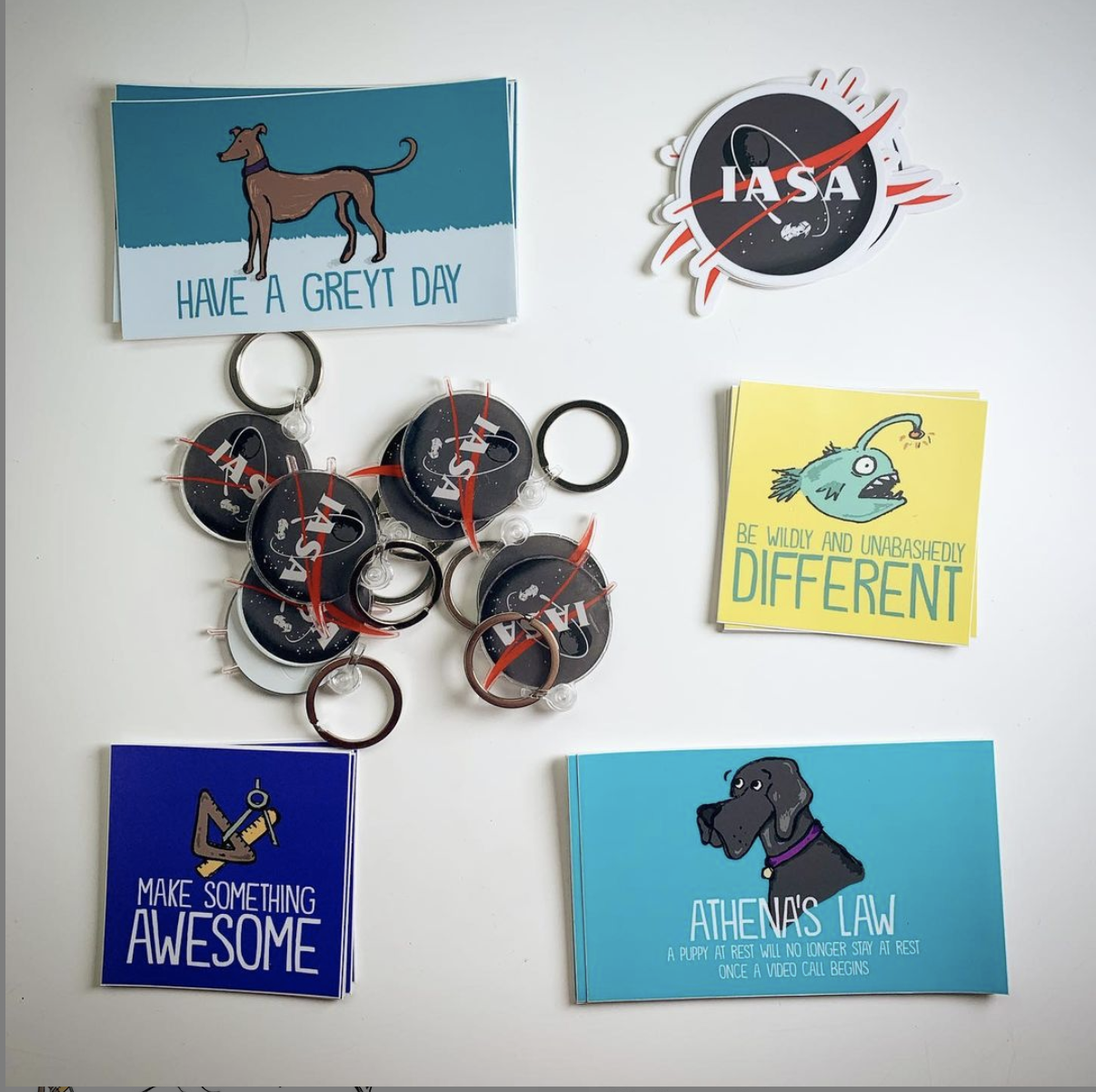 A month later, I decided to share these works with my readers and a few folks bought them. I hacked together a store inside my website but really didn’t do much with it. I told myself that I didn’t want to alienate my audience by pushing merchandise. But the truth is, I was afraid. I was afraid that people wouldn’t like what I had created. I thought that they would find the sketches to be sloppy. Besides, I’m a professor and not an illustrator, right? However, over the winter break, I was reminded of my former 8th grade teacher who said, “when you hide your voice, you rob the world of your creativity.”
A month later, I decided to share these works with my readers and a few folks bought them. I hacked together a store inside my website but really didn’t do much with it. I told myself that I didn’t want to alienate my audience by pushing merchandise. But the truth is, I was afraid. I was afraid that people wouldn’t like what I had created. I thought that they would find the sketches to be sloppy. Besides, I’m a professor and not an illustrator, right? However, over the winter break, I was reminded of my former 8th grade teacher who said, “when you hide your voice, you rob the world of your creativity.”
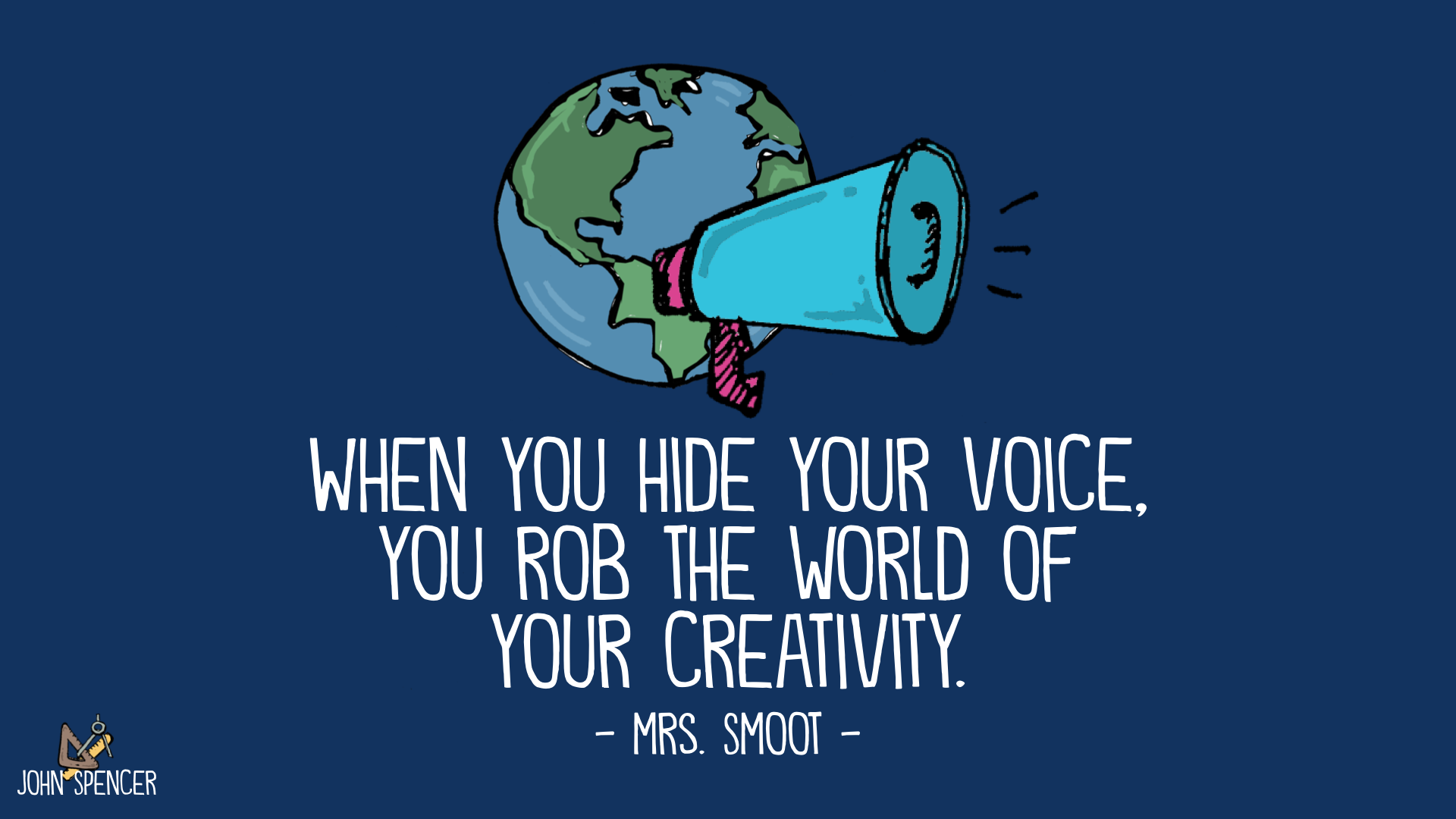 So, this year, I decided to expand this little project and create an actual merchandise store.
So, this year, I decided to expand this little project and create an actual merchandise store.
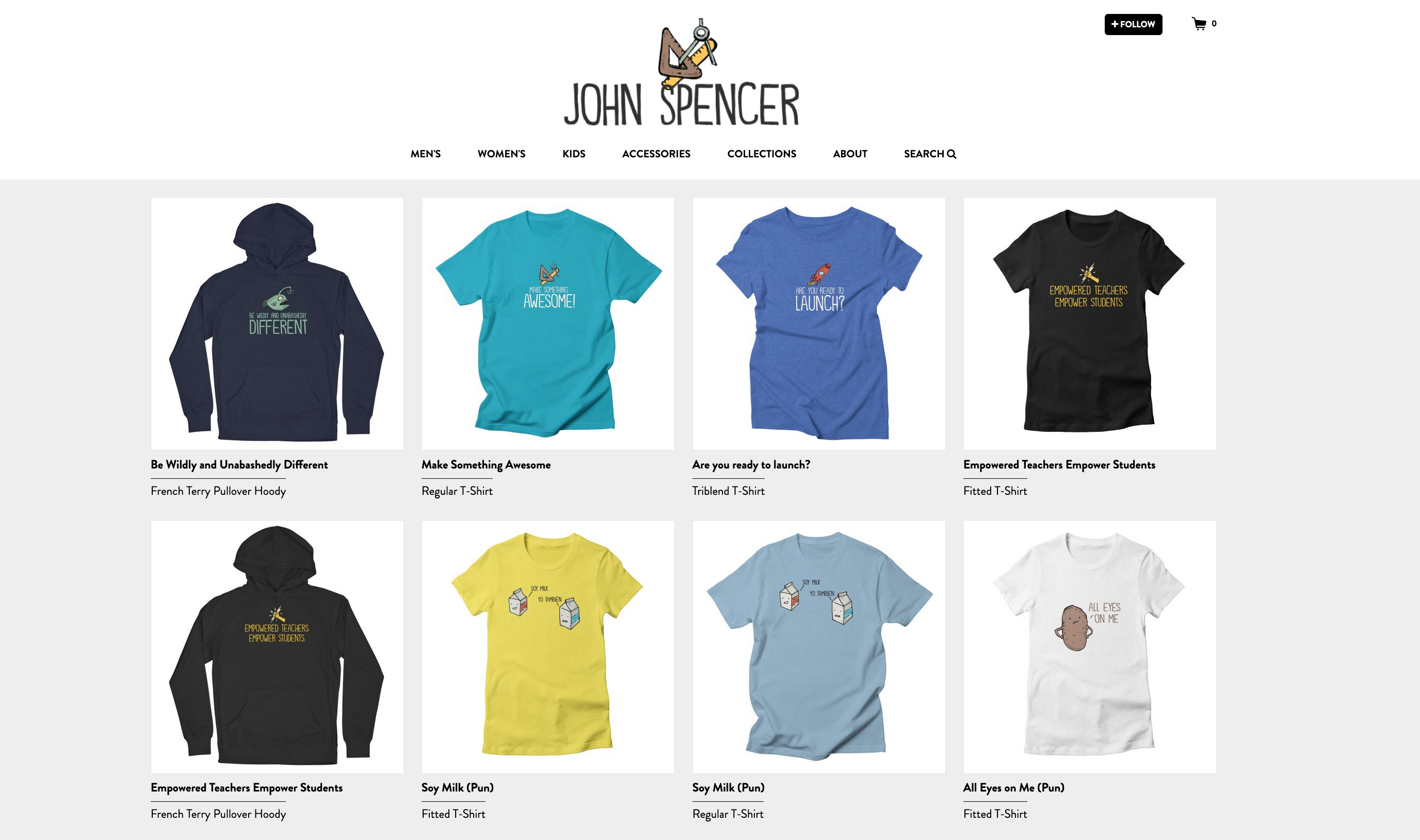
One of my favorite aspects of this has been co-creating designs with my middle son, Micah. Today, he sat in my office and I showed him how to take an image from his Remarkable 2 tablet to Photoshop, where he can then color it. All week, we’ve been bouncing ideas back and forth on an all-in-one Spirit Week t-shirt that combines eleven different spirit week themes. He’s spent hours in my office and I’ve exposed him to the Electric Light Orchestra and he got me into Feblu. Words can’t describe the inherent joy in co-designing something with your own kid. Here’s the finished result. You can find the men’s version here.
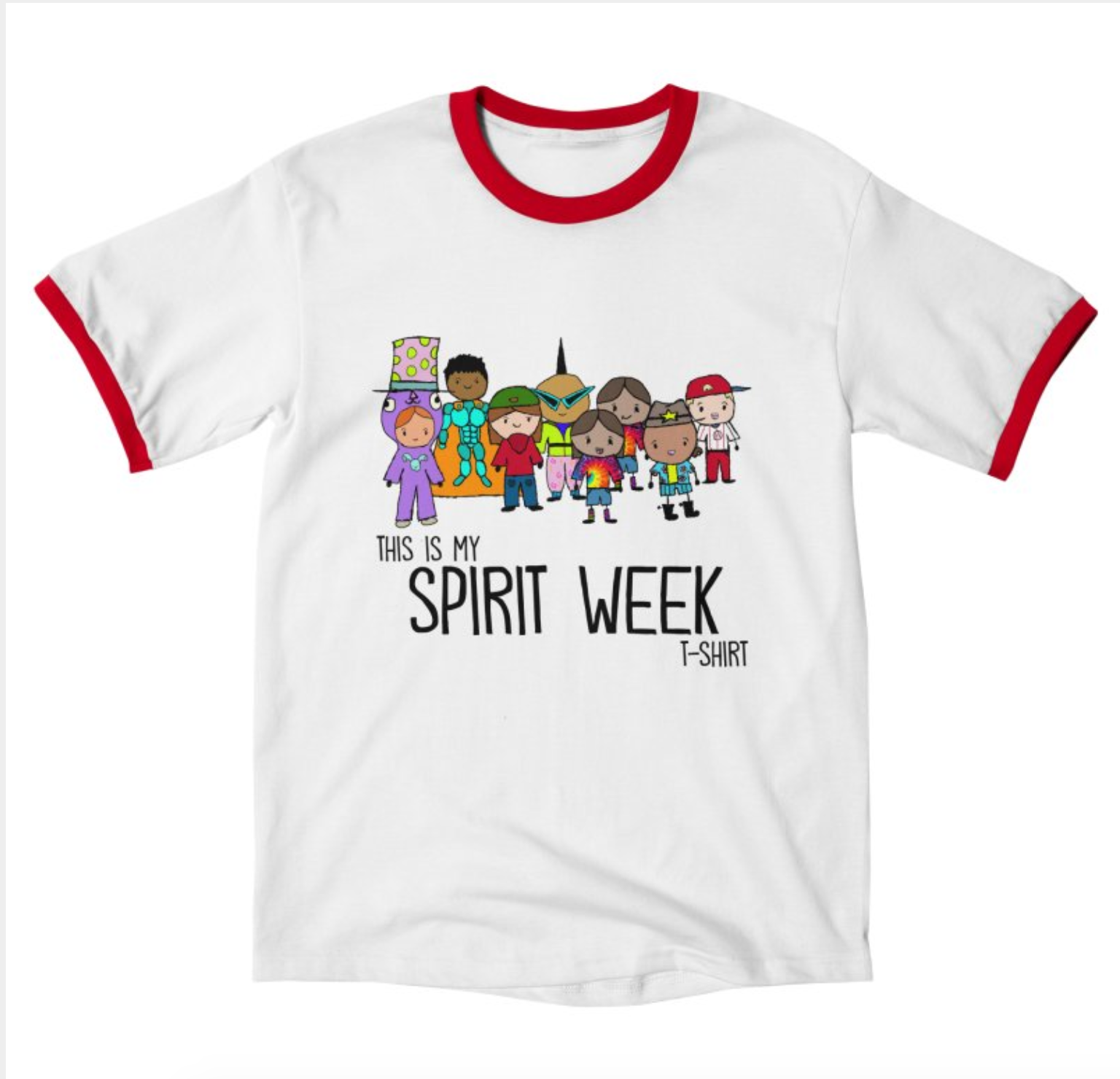 While you can find education-related items, I have a whole section for dog lovers. Right now, it’s mostly greyhound merchandise but I’ll be adding pictures related to other breeds as well. I also decided to embrace my love of visual puns by creating a collection “For Pun-Loving People Who Appreciate Cringey Dad Jokes.” Just a warning. These are pretty cornball:
While you can find education-related items, I have a whole section for dog lovers. Right now, it’s mostly greyhound merchandise but I’ll be adding pictures related to other breeds as well. I also decided to embrace my love of visual puns by creating a collection “For Pun-Loving People Who Appreciate Cringey Dad Jokes.” Just a warning. These are pretty cornball:
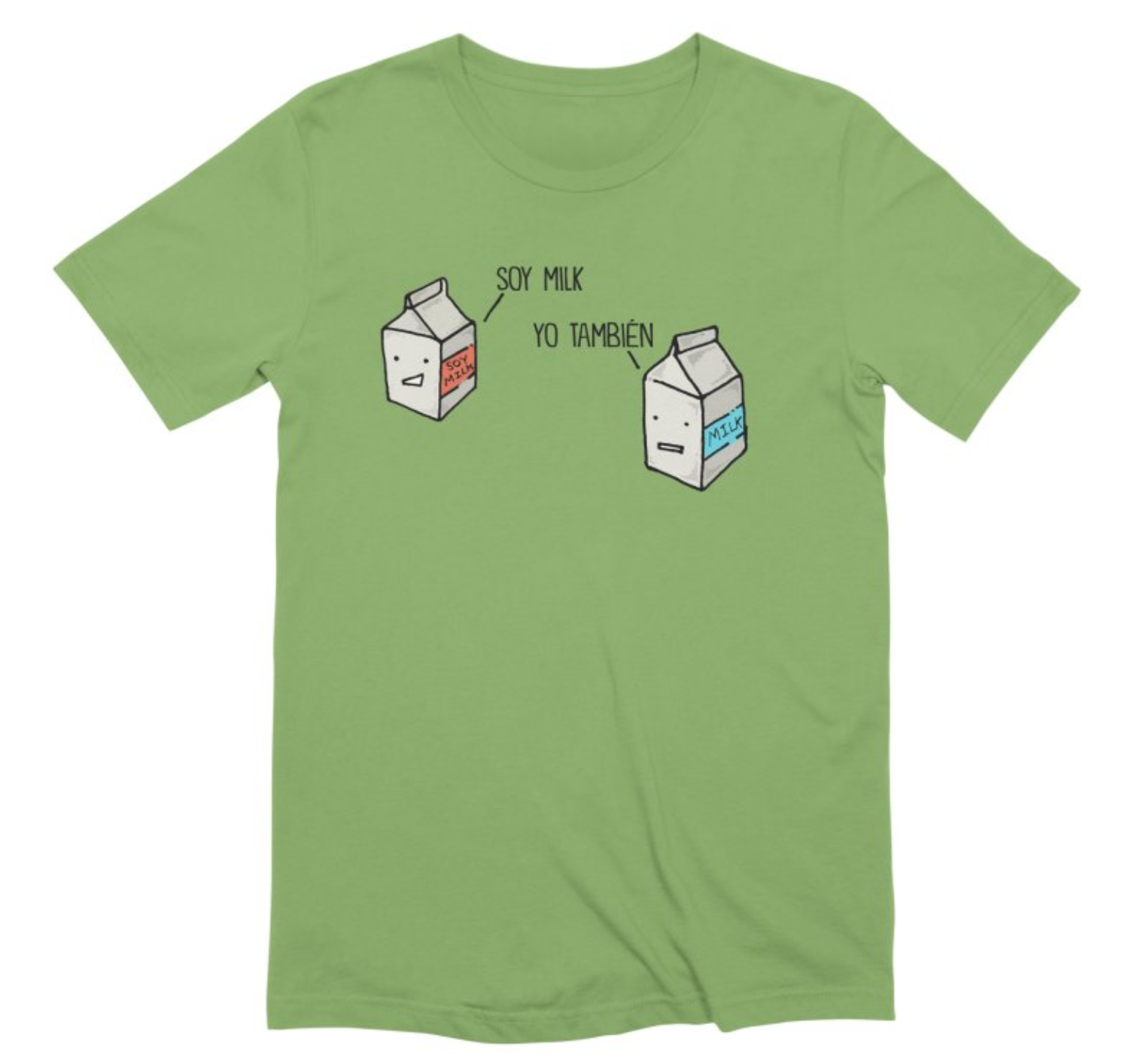 This is a throwback to a tradition I had when I taught middle school. I used to sketch visual puns on the back whiteboard. It had no educational purpose but it was a part of developing a culture of joy and humor. So, I’m adding these items to the store. I have no idea if they’ll sell. I have a hunch that they won’t. But they make me smile and, who knows, maybe they’ll make someone else smile as well. The truth is, this project is pretty low-pressure. The cost is really low (my time) and if it fails, there are no real consequences to it. I’m treating it as an experiment.
This is a throwback to a tradition I had when I taught middle school. I used to sketch visual puns on the back whiteboard. It had no educational purpose but it was a part of developing a culture of joy and humor. So, I’m adding these items to the store. I have no idea if they’ll sell. I have a hunch that they won’t. But they make me smile and, who knows, maybe they’ll make someone else smile as well. The truth is, this project is pretty low-pressure. The cost is really low (my time) and if it fails, there are no real consequences to it. I’m treating it as an experiment.
Choosing a Personal Genius Hour
This merchandise store is all part of a personal Genius Hour project. If you’re not familiar, Genius Hour, or 20% Time, is an idea that educators have borrowed from Google. However, it actually originated with 3M, where they would provide employees with 20% of their time to work on personal passion projects. In education, teachers will give their students 20% of their class time to learn what they want. The students choose the content while also mastering skills and hitting the academic standards.
With Genius Hour, students own the entire journey. They choose the topics based upon their own geeky interests. It doesn’t have to be a traditionally academic area. They might like fashion or food or sports or Legos or Minecraft or deep sea creatures Students ask the questions and engage in their own research to find the answers. Along the way, they design their own plan of instruction. They decide on the resources and activities. Each student sets goals and engages in self-assessment. They work at their own pace and set their own deadlines. Students decide on the grouping. Some work alone. Others work in pairs or small groups. In the end, students figure out what they will make and how they will share their learning with the world.
Genius Hour involves the overlap of creativity and curiosity.
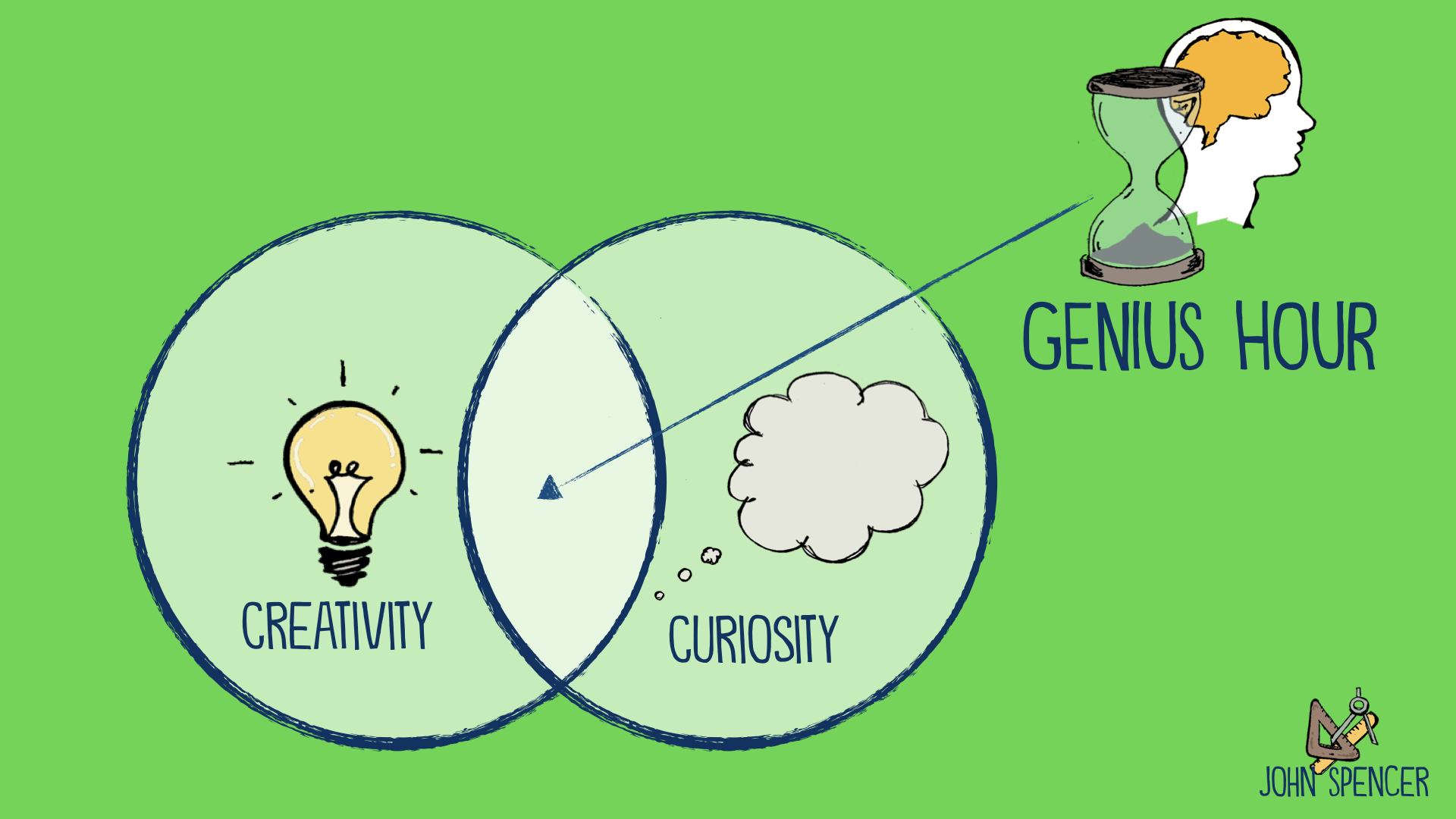 Students should be chasing their curiosity and learning new things. These might be facts or concepts but they might involve mastering new skills. In addition, each student should create some kind of product that represents what they’ve learned. They might document their learning in a podcast or video. However, they might create a physical object, like an Arduino-driven pinball machine.
Students should be chasing their curiosity and learning new things. These might be facts or concepts but they might involve mastering new skills. In addition, each student should create some kind of product that represents what they’ve learned. They might document their learning in a podcast or video. However, they might create a physical object, like an Arduino-driven pinball machine.
Although we tend to think of Genius Hour as a process for students, I want to explore how we might use Genius Hour in our own lives as educators as a form of professional development. Here, you might spend hour Genius Hour acquiring a new skill. You might learn a new language or learn how to play a new instrument. Or you might question you have and engage in your own personal Wonder Day project.
A year ago, my Genius Hour involved creating this silhouette artwork for my office:
 As a professor, I am fortunate enough to have a single work day that is longer, which allows me to take Fridays off as a Genius Hour day. However, when I was in the classroom, I would carve out a personal Genius Hour on Thursday nights. My wife would watch the kids and I would take off and work on personal projects. Should would then take off Tuesday nights for her own Genius Hour.
As a professor, I am fortunate enough to have a single work day that is longer, which allows me to take Fridays off as a Genius Hour day. However, when I was in the classroom, I would carve out a personal Genius Hour on Thursday nights. My wife would watch the kids and I would take off and work on personal projects. Should would then take off Tuesday nights for her own Genius Hour.
I actually consider Genius Hour as a form of professional development.
- It forces me to struggle with a new craft or concept, which then helps me understand resilience and grit at a deeper level.
- I get to do creative work outside my normal domain of education which can, in turn, help me bring ideas from other domains into my teaching craft. For example, by learning how to do video production, I can create better videos for my students when I’m teaching.
- I become a little more empathetic toward my own students. I experience the highs and lows of learning something new. As a professor, my students are pre-service teachers who are facing the huge challenge of learning to master the teaching craft. When I’m learning a new craft (outside of teaching) I become more patient and empathetic with them.
So, how do you go about doing a personal Genius Hour project? It helps to plan it out in a way that is experimental. The following are some ideas you might use for a personal Genius Hour project as well as the Genius Hour Projects you do with students.
Listen to the Podcast
If you enjoy this blog but you’d like to listen to it on the go, just click on the audio below or subscribe via Apple Podcasts (ideal for iOS users) on Stitcher (ideal for Android users), on Amazon Podcasts, or on Spotify.
https://spencerauthor.com/wp-content/uploads/2021/01/Genius-Hour-Experiment.mp3
Step One: Set Up Genius Hour Rules
Before getting started with Genius Hour, it can help to set up some rules or parameters to guide the process.
For Teachers:
Each year, I begin my Genius Hour by coming up with a list of rules. This year, these are my rules:
- There are no time deadlines. I am a huge fan of using time deadlines as a form of creative constraint. However, Genius Hour projects are meant to be deliberately loose. I have to shut off the ultra-planner side of my brain when I sit down to work.
- Do something new that stretches you. This is a safe space to take creative risks.
- It can’t be about education. If I create something related to education, it slowly becomes an educator version of study hall, where I used the time to get extra work done.
- Work on what you love. This isn’t meant to be a grind. I am a huge fan of pushing through the parts of your job that aren’t enjoyable because you find them intrinsically meaningful. It’s why I grade papers when I don’t feel like it. But this is different. It’s meant to be fun.
- Failure is allowed. Many Genius Hour projects will fail . . . and that’s perfectly acceptable. There is no pressure to launch this work to a larger audience.
- Present your journey at the end. My friend AJ creates a “failure report” at the end of the year and I love that idea. It’s his way of saying, “I took risks and some of them didn’t work.” So, at the end of this year, I will be sharing which projects I did and how they went.
- Nothing is stupid. There are no dumb creative works here because the process itself is the goal. There are no stupid questions. Nothing is too shallow or too nerdy or too “off-topic” to pursue.
For Students:
The rules will vary slightly for students but you can negotiate these ideas with the whole class. I found that my students didn’t need the rule “this isn’t meant to be a grind” but instead needed the rule, “get started and try, even if you aren’t feeling it today.” They tended to face greater fear and needed the reminder to get started. Moreover, students had developed less creative endurance and Genius Hour was a chance to develop that by being self-driven.
Step Two: Create a Brainstorm of Ideas
After coming up with personal rules for yourself, you might want to generate ideas.
For Teachers:
Make a list of anything you want to create or anything you want to learn. It’s important to remember that you have no obligation to finish any of these projects. The following are my ideas for this year. This is an ever-expanding list that will change as they year goes by.
- Write a fiction book. I have a few ideas percolating in my brain right now.
- Write The Great Gatsby But With Dogs. Nobody asked for it and it might not even sell. However, when I heard that The Great Gatsby was going into the public domain, I thought, “You know what this book needs? Dogs.” So, I’ll be lightly editing the book to make each character a dog and I’ll be creating visuals for it. Who knows? If this book turns out well, I might start a whole series called Canine Classics.
- Create the dog comic strip. I’ve tried and failed several times but I have a comic strip I want to create.
- Launch the grilled cheese channel with my kids. On each episode, we will experiment with a new way of creating grilled cheese sandwiches.
- Open a merchandise store. I’ve already started on this one and I’m having a blast.
- Create a creativity notebook focused on the idea of building creative momentum each day. I’ve already started on this one with my friend Matt Miller, who is an amazing graphic designer.
Note that it is hard for me to accept the fact that I won’t complete every project. But that’s perfectly acceptable. I recently read the book Messy by Tim Harford and he described how some of the most prolific artists, writers, scientists, and engineers were haphazard with their projects. But this messy element actually allowed for better cross-polination between ideas and projects. This, then, led to deeper innovations.
For Students:
You might want to have students brainstorm their ideas collaboratively. Each student also determine if they want to work alone or with pairs or small groups. If you teach a particular content area, you might need to have students create their list within the parameter of the subject area. So, you might ask students, “What type of history-related item do you want to create?” or “What historical questions do you want to pursue?”
Step Three: Carve Out Time
Once you have created your ideas, you will need to set aside time for projects.
For Teachers:
You might choose a specific evening as your Genius Hour. Or you might choose to do a Genius Hour during your spring break, summer break, or winter break. If you’re a classroom teacher, you might do Genius Hour with your students and model the process. Regardless of your approach, it’s key to treat this time as an appointment. I always put the Genius Hour time in my calendar and treat it as if I were going to an important meeting. It also helps to use Genius Hour as a personal reward project. If I finish my work early, I will often choose my Genius Hour project as a reward activity rather than cruising social media.
For Students:
There are a few options here. First, you might choose an hour each day and devote that to Genius Hour projects. Or you might choose a single day and allow for students to get into a deeper rhythm. Another option might be to take the last week of the semester and use that as your Genius Hour time. It’s important that all students have access to this time, regardless of how they are doing academically. It’s also critical that students understand that this isn’t free time or study hall. You might provide a structure such as the publishing process, the design thinking process, or the inquiry process if it feels too daunting for students.
Step Four: Treat Each Genius Hour Project as An Experiment
As you begin doing your Genius Hour project, you will notice that some projects work and others don’t. It’s perfectly acceptable to abandon projects or to jump from one unfinished project to the next. This might feel undisciplined and haphazard but it’s actually part of the creative process. Walking away and allowing for an incubation period is sometimes precisely what you need in order to continue. As a teacher, I had a really hard time with this. I wanted students to stick with a project and complete it. But I eventually realized that the value wasn’t in the finished product but in the process and journey. More importantly, the deepest values was in the learning that occurred along the way. The following grid can be a helpful way to think about “failed projects.”
The goal, then, is to treat each Genius Hour as an experiment. If the experiment fails, it isn’t actually a failed experiment. It is merely a null hypothesis. In other words, the value is in the way students gather data, analyze results, and learn from the process.
The post Treat Each Genius Hour Project as an Experiment appeared first on John Spencer.
